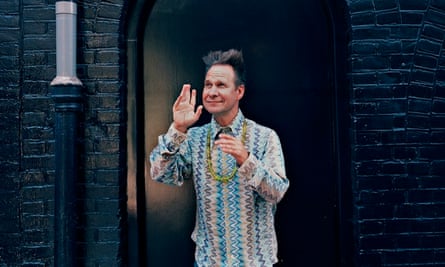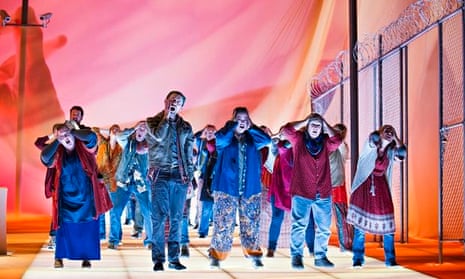Their voices are almost completely missing from the Bible, yet it was women who were closest to Jesus in his final days. The Gospel According to the Other Mary, a new opera by John Adams, tells the story of that tumultuous time through what those women saw and experienced. In addition to the scriptures, the libretto draws on work by 20th-century writers, including Primo Levi and the journalist and activist Dorothy Day. Through their words, we are able to look at Mary and her sister Martha in much more depth – and also tell the story of today’s dispossessed and disempowered generation.
You could take the piece in any number of directions, but for me there was only one way. The production I am directing for English National Opera is set today, in Los Angeles’s Skid Row. Mary and Martha have opened a house of hospitality for homeless and unemployed women, which survives on small donations and small miracles.
Day, whose words form much of the libretto, was one of the founders of the Catholic Worker Movement and its newspaper. In the early 1930s, during the Great Depression, she opened the first soup kitchens in the Bowery and the Lower East Side of New York. They were for homeless people who had lost their jobs and were desperate. These were educated people, but like today there were no jobs. The New Yorker has called her “a saint for the Occupy era” and she was deeply radical: the church she believed in was “the church of immigrants, the church of the poor”. It wasn’t enough to give someone a meal, she said, you had to give them a sense of what it is to feel whole. Jesus, she said, was not on Earth to be with the “decent poor”. He was here to be with the deranged, the drunken, the degraded, the difficult.

Adams and I responded strongly to this idea. Today, on both sides of the Atlantic, we have abandoned the poor and openly attacked the most vulnerable in society. But what also appealed to us was Day’s rawness and honesty about the struggle of trying to actually live your convictions, and not just have them as nice ideas. She was arrested many times, the first occasion at the age of 20 for picketing the White House on behalf of women’s suffrage. The last arrest came when she was in her 70s, protesting for the rights of farm workers. This felt telling: in the US, the next generation’s struggle will be over food, who grows it and how.
It was important for us to connect the opera to the plight of migrant workers in California and across the US, still the poorest and worst-treated employees in the country. The immigration law is used to provide a workforce of slave labour. The conditions they work under are obscene: the strawberries they pick are covered in pesticides, meaning the women have miscarriages and shorter lives. But if anybody complains, the immigration department is contacted and they’re deported.
For me, the point about sacred material is that it’s not something that happened 2,000 years ago. It’s contemporary. The great painters – Rembrandt, Rogier van der Weyden, Bruegel – depicted their own times. The events they portray ask us where we stand, who we are, what we’re doing right now. Bruegel’s religious scenes have people working in the fields, squabbling, eating, going about their daily business. I find the same sense of immediacy in the Bach passions. They’re about what we did this morning and what we’re doing tonight, and the values they represent are deeply attached to universal questions of justice, reconciliation, restoration, suffering, illness, recovery and resurrection. These are challenging issues, but if we’re not willing to be challenged, we’re missing out on what life is asking of us.
Opera can make such a challenge beautiful. Even if some of its truths are difficult, Adams’s music is ravishing, taking you deep into a place you would otherwise hesitate to go. Music is not about itself. It’s about everything else we think, feel and care about. What I get to do is put music on a stage, and thereby people’s lives and hopes, too. We all need these mirrors, though we don’t always appreciate what we see in them. In fact, the usual thing to do is blame the mirror. But it’s the artist’s job to reflect back to society things that don’t always get seen with sharpness or moral intensity.
This could not be more important today, which is a fragile time for free speech. Sometimes I think we know more about the fall of Rome than we do about what’s going on in, say, America right now. The news is just bits and pieces that float about everywhere. Very rarely is there a composite picture that puts all these bits together to provide a larger narrative – to explain that this demonstration or that bomb attack is part of a growing pattern, that it has a history and heralds a future.

Nearly 30 years ago, the passenger liner Achille Lauro was hijacked by Palestinians, who murdered and threw overboard an American Jew called Leon Klinghoffer. The story occupied the news for two weeks, then disappeared. What was the story of the century that preceded this? What was its aftermath in real terms? We need a more spacious medium than newspaper or television to address such questions.
John Adams took up this challenge in 1991 with his opera The Death of Klinghoffer. Opera has always spoken to a cross-section of society. Its roots lie in Greek dramas, which were about the most difficult and dangerous topics, recognising that we can only face them if we face them as one. Opera uses music, poetry, dance and visual art to draw the widest range of people together, people who are wired in different ways. It then puts them inside rather than outside the experience.
Looking at something does not mean you’re endorsing it. One can abhor an event, yes, but one also needs to understand it. Yet the US today is coming close to censorship. Nobody is allowed to discuss Palestine. Nobody is allowed to mention Palestinians, much less depict them. Most Americans have no idea about the history of Palestinians, or what their situation is now. When The Death of Klinghoffer was staged at New York’s Metropolitan Opera last month, it was picketed – and exploited – by extreme special-interest groups who had no interest in the actual opera, or indeed any opera.

Will The Gospel According to the Other Mary prove as controversial? Art and artists need to put forward things that are challenging, to not let any one argument dominate, to give a platform to voices society doesn’t want to hear. As Klinghoffer’s librettist, Alice Goodman, says, we must try to make every character equally eloquent – so we can begin to listen to their voices.
Peter Sellars was talking to Imogen Tilden
